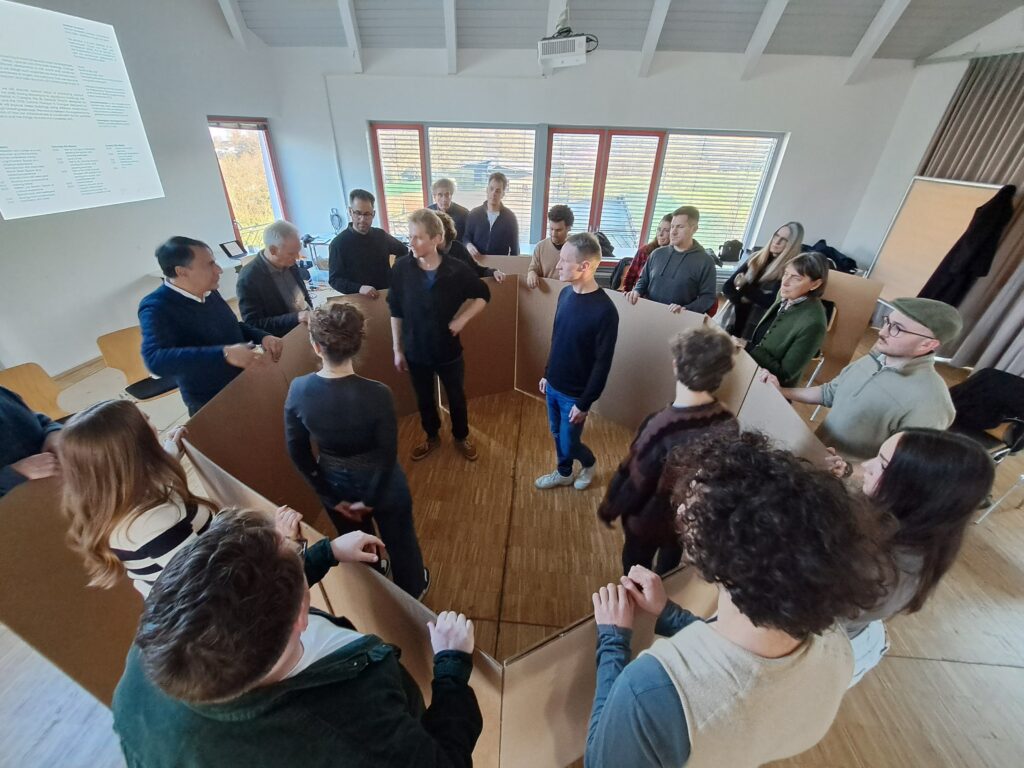The reflection of architecture in the physical body of the human being
After I was given the task of coordinating the architecture department of the Section for Fine Arts at the Goetheanum in 2000, I encountered various approaches to looking at buildings. The one that occurred most frequently and was labelled « Goetheanistic » by its representatives involved first of all a precise description of the object of observation. Lines, shapes, colours etc. were described in detail, e.g. in a group exercise. However, no particular insight was gained concerning the impact, meaning or essence of the building. What usually happened was that, after the description, people went back to emotional judgements and impressions, which seemed rather questionable to me. Certainly a close observation of the object can be helpful, but a deeper understanding of the architecture cannot come from the description of the physical features alone. I had the feeling that it should be more about the inner attitude of the viewer if one wants to perceive deeper aspects. One of my main concerns was to arrive at an objective experience of the influence of architecture on people. This theme plays a central role both in judging the quality of a building and in design, when the planner feels responsibility for the results of his work. Such a sense of responsibility is one of the foundations, perhaps the most important, for the emergence of organic design, which differs from other approaches precisely in its rejection of the arbitrary. I then tried to look at buildings with the attitude of « pure perception », that is, to allow the perceptions to have an effect on me in a contemplative state without prejudices, personal feelings and thought associations and to observe the consequences of this effect. It is easier to put oneself in such a position if one engages in the exercises of the anthroposophical path of training. Thanks to this consciously practised way of looking, I soon realised that different architectural forms also evoke different sensations in the physical body and that different elements of the same building can be reflected in different places in the body and, depending on their design, cause certain resonances. If you are able to observe these effects in the body closely, you can also gain an understanding of the unconscious influence of architecture on people – right down to the civilising aspects. For example, one can experience how the point of a Gothic arch causes a feeling of concentration in one point of the body – usually in the forehead or chest area, depending on the individual’s disposition – whereby the two halves of the arch and the pillars awaken a calming feeling of downward currents in the limbs, which at the same time stimulates the individual to straighten up. From this, one can understand the general effect of Gothic in strengthening individual consciousness as a precursor to the Renaissance. Such results are not subjective, because experience shows that all people who can develop the contemplative attitude described above – and with a little guidance, almost everyone can – develop similar sensations. Over the years, I have undertaken contemplations with groups of architects and lay people from very different countries and age groups, and I have always been amazed at how quickly most of the participants were able to come to their own objective perceptions. Even those who find it difficult to abandon the usual way of looking at things can usually, with a little effort, direct their attention to the effects in their own bodies. I initially developed the approach described in connection with architectural forms consisting of constructive or decorative elements. In the perception of space, the single elements and the construction do not play the main role. The effect of space is also different from that of forms. It does not manifest itself through its influence on certain areas of the body. In order to perceive it consciously, one must also become active in the contemplative posture and feel the spatial boundaries inwardly, as if one were adapting one’s own body to the spatial form. It is also important to feel the shape of the space as if in an inner movement. When you do this, you experience the effect of the space on your body and soul. It is more difficult to grasp than the effect of the architectural elements, especially with complex designs. But even with relatively simple rooms, you get different impressions from different points of view. The task is then to bring the variety of experiences together inwardly in order to gradually reach an experience of the essential qualities. In order to practise this kind of spatial observation before moving on to real situations, I often first suggest group work in which the participants create different room layouts from cardboard or plastic sheets measuring around 1 x 1.5 metres and try to experience them from the inside. Even under such simple and somewhat abstract circumstances, the participants get strong impressions and can thus experience and compare the effect of shapes such as polygons and ovals. If you change the basic shape – e.g. from a triangle to a hexagon – without the viewers leaving the interior space formed, you can even notice in the facial expressions and gestures how immediately the mood changes in the transition from one shape to the other.

Again, it is obvious from such experiments that the effects experienced are by no means subjective and arbitrary. However, they remain largely unconscious for those who do not pay attention to them. The described approach helps to bring such unconscious processes to light in order to develop an understanding of the consequences of one’s own decisions, also with regard to design practice. In addition to the influences on the physical body and its etheric stream of forces, there are also those that primarily take place in the soul realm. An eminent example of this are the effects of colour and light, but also aspects of form that are less constructive and more plastic – decorative, like the ornaments in a historical building. This does not mean that the influences on the body have no effect on the soul; in fact, they are generally stronger than the pure soul effects. However, the latter are easier to grasp consciously because they take place in an area where people are more alert and used to observing. For this reason, it is unfortunately often the case that people tend to limit themselves to the emotional level when observing architecture without delving deeper. For a holistic experience, however, it is important to include all levels, especially as the mental level is more subjective than the physical level. I therefore find it helpful when looking at buildings to first become aware of the effects on the physical and only then to include the psychological effects. You will also realise that a large part of what is experienced in the soul becomes understandable through the influences on the physical. In the sense of Rudolf Steiner’s building impulse, this experience could be described as projecting the forces of the physical body into space. Thus, by observing one’s own body under the influence of architecture, one can experience the forces that have created the forms.
This article was first published in the magazine « Stil », Johanni 2024, 46th year Issue 2



